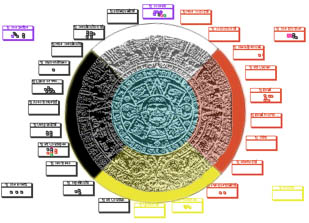Date: 94-02-07 11:13:07 EST
Dear Carolyn,
Yes, colors are definitely significant, so fundamental that I left it out. For all Mesoamerican people the world's directions each had an emblematic color. Sources vary on what these are, but all indicate that center is green-blue (more on that in a moment) and east is red and/or yellow. West is generally black, then north and south are white and yellow. I know that is redundant, but the most normalized accounts say center blue-green, east red, north white, west black, south yellow.
|
 |
Blue and green are without a doubt the most prized and significant color(s). Technically, the Aztecs did not separate as we do the entire blue-green range. So all those color terms are associated--with water, vegetation, growth. (Green feathers are described as like new plants sprouting, and in some Mesoamerican cultures stand for the springing forth of new children.) Of course, like all humans, Aztecs could see the difference between different shades of blue-green. They made these differences concrete by using gem names for them: turquoise, xiuhuitl; jade, chalchiutl. Blue then was associated with sky, and with sacred fire. Jade with vegetation and sweet waters of the earth.
Yellow was the color of the sun and of light. Gold, the metal, and also copper (which was made as an alloy with less than 13% gold, but then etched with acid to dissolve the surface copper and enrich the gold) were excrement of the sun. The idea seems to be that the sun was entirely resplendent. Yellow is not an important color until late in Mesoamerican history; the use of metals doesn't begin until ca. 800 AD.
Red was the second primary color in early Mesoamerican history, often matched in opposition to green. Red is the color of ocean water in the art of the Maya and of the central Mexican city Teotihuacan between 0 and 1000 AD. This may reflect the collapse of salt water in the ocean, and blood.
More later, R
|


